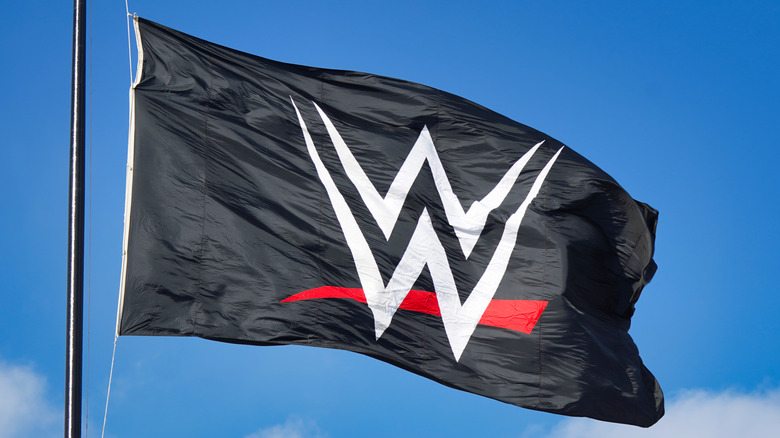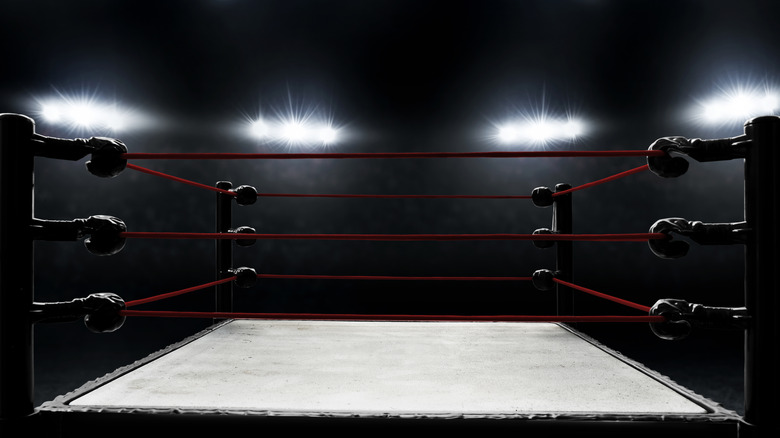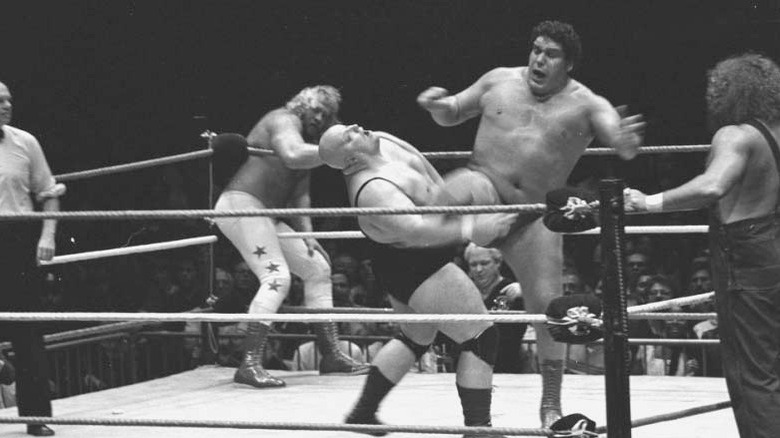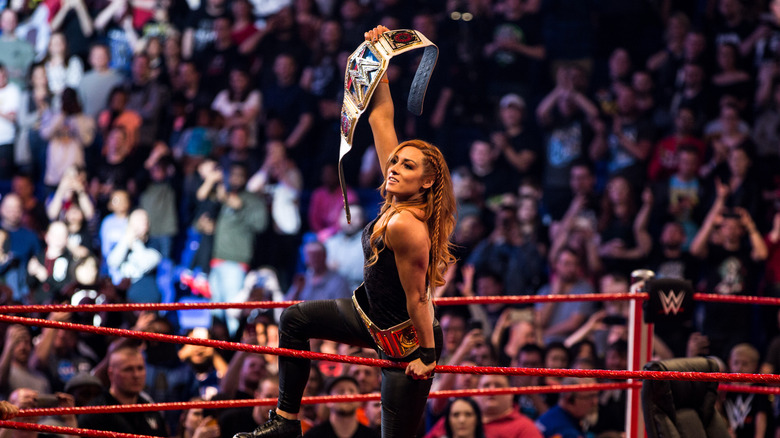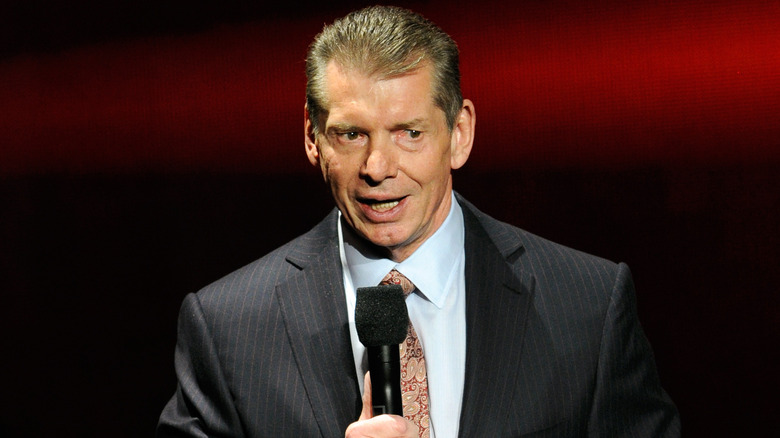How Much Is The WWE Worth?
While there are other professional wrestling promotions, it's tough to argue that World Wrestling Entertainment — formerly the World Wrestling Federation until another, panda-mascoted organization staked its claim to the abbreviation WWF — isn't the undisputed top dog. The WWE as we know it today started in 1982 when Vince McMahon purchased his dad's wrestling promotion. In the years that followed, the company revolutionized the concept of sports entertainment and has gone on to become a multi-billion dollar enterprise.
The company has produced countless stars, some of whom have even transcended wrestling and gone on to have successful careers in Hollywood, as is the case for the likes of Dwayne "The Rock" Johnson and John Cena, while others have found success in other places, even politics, like the former governor of Minnesota, Jesse "The Body" Ventura. The WWE didn't reach its multi-billion-dollar value overnight. Instead, it took several decades and several eras of wrestlers and business decisions to get there.
The early days of professional wrestling
While most people are well aware that wrestling itself is an ancient sport, they may be surprised to learn that professional wrestling, while by no means ancient, is older than they would've believed. According to Bleacher Report, the earliest version of professional wrestling dates back to just after the American Civil War. At this time, wrestling was usually part of the carnival, and shows traveled from town to town. The roster of wrestlers was usually made up of college wrestlers who would've been more than happy to have a few bucks kicked their way for their services.
Wrestling took a while to become as popular as the other most popular sports of the early 20th century, boxing and baseball. In 1925, something happened that completely altered the trajectory of professional wrestling. It occurred during a match in Kansas City between Ed "Strangler" Lewis and Wayne "Big" Munn. Lewis was the reigning champion who was expected to make quick work of Munn, a former collegiate football player. According to Atlas Obscura, Lewis was so good that some thought his matches were starting to get boring.
This is why the crowd was so shocked when Lewis lost to Munn. The incredible upset garnered lots of attention, but what the fans didn't know was that it was all fixed — or, to use wrestling jargon, a work. This went on to become the norm as professional wrestling shifted from a sport to an example of sports entertainment.
The World Wide Wrestling Federation
One of the wrestlers with a connection to Ed "Strangler" Lewis was a man with one of wrestling history's least threatening nicknames: Joseph "Toots" Mondt. While Mondt was a successful wrestler in his own right he's better remembered for his work as a promoter. According to the WWE, Mondt was part of the Gold Dust Trio, alongside Lewis and Billy Sandow. The three men are credited with developing professional wrestling into its modern form, and according to Bleacher Report, wrestling promotions around the country started following their lead.
Mondt went on to join Vincent J. McMahon, a second-generation promoter who had learned the ropes from his father, Jess McMahon, in taking over the Capitol Wrestling Corporation, which was later renamed the World Wide Wrestling Federation in 1963. Mondt died in 1976, and in 1982, McMahon sold the company to his son — Vincent K. McMahon — which by that point had been renamed the World Wrestling Federation. Under the third-generation McMahon, the WWF's popularity was set to explode in the coming decades.
The WWE's first Superstars
One of the WWE's greatest assets has been its ability to churn out a seemingly endless series of stars, but of course, that had to start somewhere. The first batch of big names is now the stuff of not just wrestling legend, but pop culture, too. Andre the Giant, "Rowdy" Roddy Piper, Jimmy "Superfly" Snuka, The Iron Sheik, Hulk Hogan, and even McMahon himself all became part of a wildly marketable stable of wrestlers. As the promotion's popularity ramped up, the WWE partnered with MTV to produce a special called "The Brawl to End It All" which included an appearance from singer Cyndi Lauper and led to some of the biggest networks the still-up-and-coming cable network had seen to that point in its history.
Hulk Hogan was one of, if not the first, to transcend wrestling; he even hosted an episode of "Saturday Night Live" in 1985. His episode aired the day before the inaugural Wrestlemania, which helped get eyes on what has since become an annual, marquee event for the WWE. In the years that followed the WWE welcomed a slew of iconic wrestlers, including "Macho Man" Randy Savage, Ric Flair, Bret "Hit Man" Hart, and The Ultimate Warrior.
The WWE's multiple revenue streams
Thanks in large part to its first crop of superstars, WWE has enjoyed continued success through the years. That includes the WWE's notorious Attitude Era, with names like "Stone Cold" Steve Austin and The Undertaker, which allowed the company to diversify its business dealings beyond TV and live shows and even wind up on the New York Stock Exchange (via WWE).
Media is a major component of the WWE's business, dealing with multiple TV agreements in place, including one with Fox for the primetime broadcast rights for "Friday Night SmackDown" and a deal with NBC Universal to broadcast "Monday Night Raw" on USA Network, which also broadcasts WWE NXT, the company's development promotion. Additionally, the company also has its own cable channel, WWE Network, which broadcasts a slew of WWE-related programming.
According to the WWE's website, the company puts on more than 500 live events each year. Wrestling at these events — as well as those that are broadcast — are WWE Superstars in the same vein as the likes of Hulk Hogan and Ric Flair. The WWE currently has around 300 Superstars under contract. The Superstars are the company's most important assets and also serve as the basis for another substantial revenue stream: merchandising.
The WWE's net worth
The WWE is broadcast in over 180 countries and has a reach of 1 billion households across the globe. That many sets of eyes mean big business, especially when the company is capable of cranking out seven hours of original programming each week that's watched by more than 11 million viewers (via the WWE).
According to Macrotrends, the WWE's net worth sits at around $5 billion in 2022. However, that's down substantially from its peak of over $7 billion between 2018 and 2019. The company's revenue has increased for the most part over the course of the 21st century and reached a peak of $1.165 billion in 2022 with gross profits of over $500 million.
Today Vince McMahon remains the Chairman of WWE. According to Sportskeeda, McMahon has a 42% ownership stake in the company and continues to wield more than 80% of the voting power. Other large portions of the company remain in the family as McMahon's daughter Stephanie McMahon and her husband, Paul Michael Levesque, better known by his ring name Triple H, also own portions of the company.
